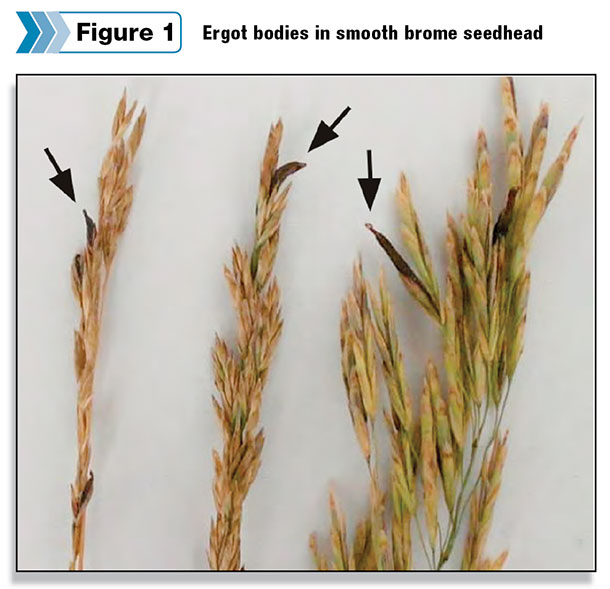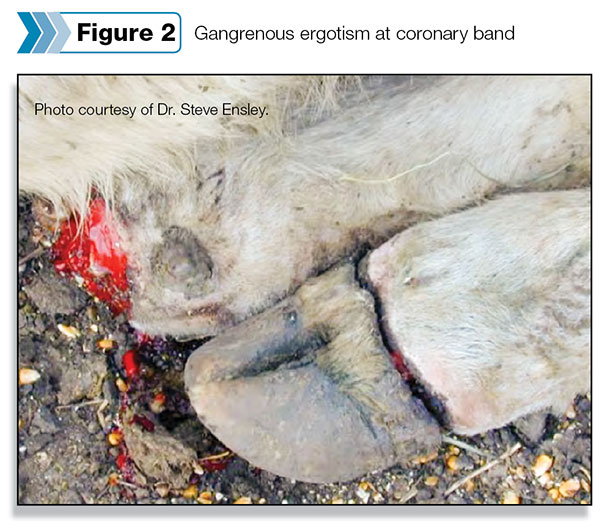Environmental conditions (cool, wet spring followed by hot early summer temperatures) are ideal for the ergot fungus to grow. Delayed harvesting of grass hay because of rain also means late-cut hay may also be at risk of ergotism.
Historically, rye was commonly affected by the ergot fungus, but wheat, barley, oats, brome, fescue, bluegrass, timothy and other grasses can also be infected. All animals are susceptible to ergot, but cattle are often most affected.
The fungus produces toxic compounds called ergot alkaloids. The type and quantity of toxic alkaloids varies depending on the specific fungus infecting the plant, the type of plant and the environmental conditions. Therefore, risk of poisoning and the specific clinical signs may vary depending on climatic conditions and species of fungus present.
To determine if pastures or hay are affected, inspect the seedheads for dark brown, purple or black bodies within the seedhead (Figure 1).
 The fungus produces a mass called the sclerotia that completely replaces the ovary tissue of the plant and is often larger than a typical seed. These sclerotia will eventually fall to the ground and overwinter.
The fungus produces a mass called the sclerotia that completely replaces the ovary tissue of the plant and is often larger than a typical seed. These sclerotia will eventually fall to the ground and overwinter.
There is no practical way to eliminate the ergot-producing fungi from pastures. The incidence and severity of future outbreaks will vary with climatic conditions. Determine presence and severity each year by careful field inspection.
Fescue grass may be at additional risk since the toxins produced by endophyte-infected fescue are very similar to ergot toxins.
Clinical signs
The most common sequel of ergot poisoning is associated with vasoconstriction of the small arteries. Vasoconstriction (constriction of blood vessels) can prevent thermoregulation and result in “summer slump.”
Cattle will commonly develop a rough hair coat, lose weight and have extended periods of time standing in water or shade if available.
Gangrenous ergotism (synonymous with fescue foot) is also a result of vasoconstriction in the legs and tail. Gangrenous ergotism is often associated with cold temperatures but can be seen in the summer also.
Initially, cattle will be lame, usually in the hind limbs first. Swelling at the coronary band develops, and the animal will eventually slough its hoof if not removed from the ergot alkaloid in time (Figure 2). Necrosis of the tail and ears can also occur.
 As with fescue toxicosis, agalactia (decreased or no milk production) can occur. Finally, nervous ergotism is sometimes reported. Nervous signs may be associated with vasoconstriction in the brain or other alkaloids that specifically cause hyperexcitability and tremors, especially with forced movement.
As with fescue toxicosis, agalactia (decreased or no milk production) can occur. Finally, nervous ergotism is sometimes reported. Nervous signs may be associated with vasoconstriction in the brain or other alkaloids that specifically cause hyperexcitability and tremors, especially with forced movement.
Diagnosis
Lameness associated with ergot poisoning should be differentiated from foot rot, fescue toxicosis, frostbite, trauma or vesicular disease. Inspection of seedheads should reveal sclerotia if ergotism is the problem. Samples of grass or hay can be analyzed for the concentration of the ergopeptides.
A 1-pound, randomly collected sample from the pasture or hay that includes seedheads is adequate for analysis. There is no specific test to detect ergopeptides in cattle.
Treatment
Treatment of ergotism is primarily focused on removing the animal from the source of the ergot toxins, as there is no antidote. Animals can recover if they are removed early enough before severe clinical signs are present. However, once gangrene has begun, there is little that can be done.
Prevention
Grass in pasture or hay should be monitored regularly to determine if the ergot sclerotia is present. Many animals will go off-feed or seek other grass not infected with the ergot fungus. However, cattle are known to selectively graze the seedhead and are more at risk than other animals on pastures.
Cattle should be removed from pastures that have ergot sclerotia present. Since the ergot fungus is only in the seedhead, grazing of infected pasture before the seedhead develops is advised. Grass that has developed a seedhead can be clipped before allowing cattle to graze. Hay produced from ergot-infested grass may be toxic as well.
Often the sclerotia will drop off of the grass as it is being handled, but hay should be inspected to make sure it does not contain sclerotia. 
![]()
Grant Dewell, DVM, is a beef extension veterinarian at Iowa State University.
Steve Ensley, DVM, is a veterinary toxicologist at Iowa State University.
References omitted due to space but are available upon request. Click here to email an editor.
—Excerpts from Iowa State University Extension publication






